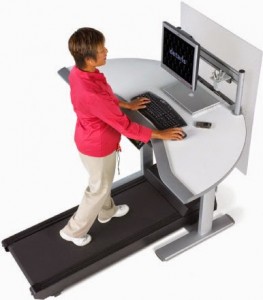If you spend less time in a chair and more time on your feet, just how effective might this be at lowering high blood pressure?
Are you a victim of “the sitting disease”?
Americans as well as many people in other industrialized nations spend entirely too much time on their can.
This problem doesn’t just occur at the workplace desk, but also at home while watching TV, using a computer or using one’s phone.
Sitting during the drive to and from work also contributes to “the sitting disease.”
Meanwhile, many people have high blood pressure and don’t even know it. This includes younger, non-overweight people who feel healthy and spry.
According to the American Heart Association, in a report published in the journal Hypertension, even little bits of increased activity go towards better cardiovascular health.
Increasing your physical activity can help lower your blood pressure and cholesterol, along with many other health benefits, says the paper.
The report also points out that there is no minimum amount of time required for benefiting from physical activity, in that even if you tack on 10 minutes of extra movement that you normally wouldn’t do, this will contribute to a more desirable blood pressure reading.
- Walk while talking on the phone; don’t sit.
- Walk the dog 10 minutes longer.
- Walk around the house during TV commercial breaks.
Exactly how does more exercise help lower blood pressure?
“It’s well-documented that people who sit for prolonged periods are more likely to have hypertension,” says Dr. David Beatty, MD, a retired general practitioner with 30+ years of experience and an instructor of general medicine for 20 years.
“It’s also been shown that increasing activity levels can lower blood pressure. The mechanism for this is mostly complex and multifactorial.
“One very simple reason is that when a person stands up, their blood pressure usually drops temporarily as blood drains to the lower extremities due to gravity.
“This leaves less blood in the central core of the body with a slightly lower pressure.
“In a healthy person this is rebalanced fairly quickly to normalize the BP.
“In extreme cases the BP can be lowered too much, causing postural hypotension associated with light-headedness or fainting.”
Another way this presents is that, as some people have described, “The room starts going black.”
Dr. Beatty continues, “Apart from this there are a combination of vascular, metabolic and nervous system factors at play.
“Exercise is associated with vasodilation (widening) of the arteries and arterioles. This allows more blood to be pumped to the muscles being used and lowers blood pressure.
“Sitting for long periods causes more sympathetic nervous system (SNS) activity, which causes vasoconstriction — leading to the opposite effect.
“The extra SNS action also reduces kidney perfusion [blood supply to the kidneys] and increases renin levels which both increase BP.
“Inactivity leads to less muscle activity so that fewer calories are burnt up
“The long-term consequences of this are obesity, a higher blood sugar, abnormal levels of cholesterol and insulin intolerance — leading to metabolic syndrome.
“These problems all further increase the risk of getting high blood pressure.”
Treadmill Desk

I’ve had a treadmill desk in my home for many years now. On it is my “secondary” computer.
When I’m sitting at my “primary” computer and find some stories I want to read, I have a choice: continue sitting on my duff to read them, or, email their links to my secondary computer so that I can walk while reading.
And that’s exactly what I do. This gives me something to do while slowly walking on the treadmill desk. Before I know it, 30 minutes have passed while reading interesting stories.
If you can’t afford a treadmill desk, then set a timer to go off 45 minutes after planting your butt in your computer chair. Then just walk around, even if it’s a mindless three-minute walk.
Or stand in place and do high knee marches or some other leg movement.
Do some dancing, jumping or trotting forward and backward. Go outside and walk to the end of the street and back.


 Dr. Beatty has worked in primary medicine, surgery, accident and emergency, OBGYN, pediatrics and chronic disease management. He is the Doctor of Medicine for
Dr. Beatty has worked in primary medicine, surgery, accident and emergency, OBGYN, pediatrics and chronic disease management. He is the Doctor of Medicine for 
























